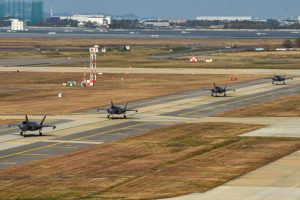North Korea fired three short-range ballistic missiles (SRBMs) off its east coast late on Thursday, South Korea’s Joint Chiefs of Staff (JCS) said.
The missiles were launched from the Goksan area of the North Hwanghae Province at around 9:30 p.m. and flew about 490 km with an altitude of 130 km.
North Korea had already launched ballistic missiles, including a suspected Hwasong-17 intercontinental ballistic missile (ICBM), earlier on Thursday as a response to the extensive joint military air drill between South Korea and the United States, known as Vigilant Storm.
However, as the South Korean and the U.S. militaries agreed to extend the schedule for Vigilant Storm due to the North’s unprecedented missile launches on Wednesday, North Korea again launched its SRBMs to show its belligerent stance over the decision.
About two hours after the North launched three SRBMs, it also fired at least 80 artillery shells off its east coast from the Geumgang area of Gangwon Province at 11:28 p.m.
Before the nighttime launches, Korea Central News Agency (KCNA), one of the North’s main state-controlled media, published a statement from Pak Jong Chon, a secretary of the Central Committee of the Workers’ Party of Korea (WPK), to condemn the extension of the South Korea-U.S. military drills and warn of follow-up measures.
“The irresponsible decision of the U.S. and South Korea is shoving the present situation caused by provocative military acts of the allied forces to an uncontrollable phase,” Pak said.
“The U.S. and South Korea will get to know what an irrevocable and awful mistake they made” by extending Vigilant Storm, Pak said.
On Friday, the South Korean military detected more than 180 North Korean military aircraft flying in various areas. As a response, the South’s Air Force mobilized about 80 fighter jets including its F-35A stealth jets.
This week, North Korea launched at least 33 missiles and 180 artillery shells while South Korea and the United States conducting joint military air drills involving about 240 fighter jets. This year’s Vigilant Storm is reportedly the largest joint air exercise in the alliance’s history.
Since South Korean President Yoon Suk-yeol took office in May, South Korea and the United States have reinvigorated their joint military drills, which provoked the North to test-fire ballistic missiles toward its east and west coasts. USS Ronald Reagan, the U.S. nuclear-powered aircraft carrier, was deployed in the waters off the South’s east coast for the joint navy drill with South Korea in late September, the first such deployments since 2017.
North Korea had already denounced the series of extensive joint military drills between South Korea and the United States this week, indicating that its missile launches are “defensive” as a tit-for-tat measure to the military activities of the South and the U.S.
However, South Korea and the U.S. are not backing down.
The U.S. Defense Department published the 2022 Nuclear Posture Review, stating that the North Korean regime will end if it attacks the U.S. and its allies with its nuclear weapons. In the 54th Security Consultative Meeting (SCM) held in Washington, D.C., on Thursday, South Korea and the United States reaffirmed that the North Korean regime would not survive if it uses nuclear weapons against its so-called adversaries in the region.
“Secretary Austin and I affirmed that any nuclear attack by the DPRK, including the use of tactical nuclear weapons, is unacceptable and result in the end of Kim Jong-un regime by the overwhelming and decisive response of the alliance,” South Korean Defense Minister Lee Jong-sup said during the joint news conference after the meeting. He also added that “this is a strong warning against the DPRK.” (DPRK is an acronym of the North’s official name: Democratic People’s Republic of Korea.)
The phrase “the end of the Kim regime” also appeared on the joint communique of the 54th SCM. North Korea has shown extreme sensitivity to any threats targeting Kim Jong Un or his regime specifically and will likely take additional follow-up measures in response – which will escalate the tensions on the Korean Peninsula further.

































